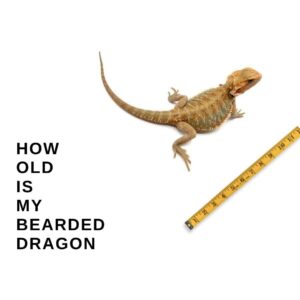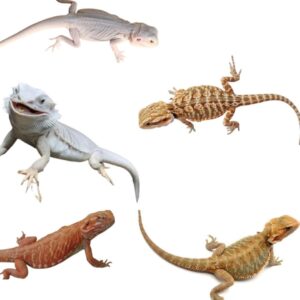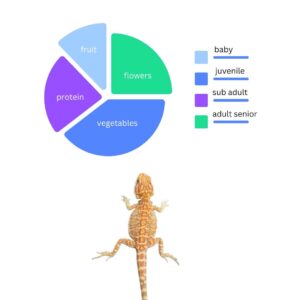Known for its stunning appearance, friendly demeanor, and manageable size, the German Giant Bearded Dragon has become a popular choice for reptile keepers and hobbyists.
The German Giant Bearded Dragon is a unique and fascinating reptile that requires special care and attention.
In this article, we will explore the various aspects of caring for this magnificent creature, covering topics ranging from their origin and characteristics to setting up the perfect habitat, meeting their nutritional needs, and ensuring their health and wellness.
So, let’s dive into the world of the German Giant Bearded Dragon and learn how to provide them with the best possible care.
German Giant Bearded Dragon in a nutshell
| Size | Nutrition | Health issues | Life expectancy |
| Up to 24-inch | Omnivorous | metabolic bone disease, respiratory infections, parasites, and digestive problems | Up to 12 years |
German Giant Bearded Dragon: Table of Contents
Origin and Characteristics of the German Giant Bearded Dragon
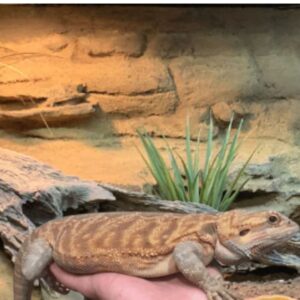
The German Giant Bearded Dragon shares its roots with the central bearded dragon, originating from the arid and semi-arid regions of Australia. These regions are known for their harsh climate, with scorching temperatures and limited water sources.
These dragons have been selectively bred over the years, just like other unique morphs, leading to the emergence of the “giant” variety.
Their bodies are adorned with a blend of earthy tones, ranging from sandy yellows to dark browns, providing them with effective camouflage in their natural habitats. The distinct spikes and frills around their head and neck lend them their characteristic regal appearance.
German Giant Bearded Dragon Size
One of the most striking characteristics of the German Giant Bearded Dragon is its size.
Growing up to 24 inches in length, these lizards are significantly larger than their common counterparts.
Males typically tend to be larger than females, showcasing their impressive size and strength. The increased size of these lizards also means that they require spacious enclosures to move around comfortably. Providing them with ample space is crucial for their physical and mental well-being.
This increase in size is believed to be an evolutionary response to the need for greater body mass to withstand the extreme temperatures of their native habitat.
German Giant Bearded Dragon Colors
In addition to their impressive size, German Giant Bearded Dragons also display a range of vibrant colors.
Their scales can vary from earthy tones to bright yellows and oranges, providing them with effective camouflage in their natural environment. These colors also serve as an aesthetic feature, making them an attractive choice for reptile enthusiasts.
The lifespan of the German Giant Bearded Dragon
With proper care, a German Giant Bearded Dragon can live up to 12 years or more. However, their lifespan largely depends on their environment and overall health.
These reptiles require specific conditions to thrive, including appropriate temperature gradients, UVB lighting, and a balanced diet.
German Giant Bearded Dragon Diet
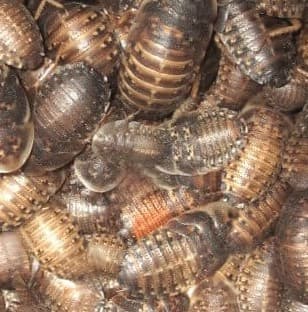
When it comes to their diet, German Giant Bearded Dragons are omnivorous, consuming a variety of insects, vegetables, and fruits.
A well-balanced diet is essential for the health of your German Giant Bearded Dragon. These omnivorous reptiles enjoy:
- live insects,
- leafy greens,
- occasional fruits
Popular feeder insects include crickets, dubia roaches, and black soldier fly larvae.
Calcium and vitamin supplements are crucial to prevent common nutritional deficiencies
Feeding Schedule and Portion Sizes
Juveniles should be fed once or twice a day, while adults can be fed every other day.
A rough guideline is to offer as much food as they can consume within 5-10 minutes, without overfeeding.
Importance of Hydration
Hydration is vital for the health of your German Giant Bearded Dragon.
In addition to a shallow water dish for drinking, regular baths help with shedding. Soaki your dragon in lukewarm water for 15-20 minutes, a few times a week.
Behavioral Traits and Temperament
German Giant Bearded Dragons are known for their docile and friendly nature. Unlike some other reptiles, they tend to tolerate human interaction well and can become quite accustomed to handling. Regular socialization with their owners can lead to a strong bond between the dragon and its keeper.
Breeding and Reproduction
Breeding German Giant Bearded Dragons requires careful planning and a controlled environment. Females lay clutches of eggs that need to be incubated at specific temperatures. Successful breeding can result in adorable hatchlings that will require attentive care during their early stages of life.
Choosing the Right Enclosure
A glass terrarium or a custom-built wooden enclosure of at least 55 gallons is recommended to provide ample room for your pet to roam and bask. Ensure the enclosure has a secure lid to prevent any escape attempts, as these lizards are excellent climbers.
Keeping a German Giant Bearded Dragon as a pet requires careful attention to its enclosure setup. A spacious terrarium with proper heating, lighting, and a basking area is essential.
The enclosure should mimic their natural habitat, offering hiding spots and climbing opportunities. Additionally, maintaining the correct temperature and humidity levels is vital for their health.
Ideal Temperature and Lighting Conditions
Maintaining a basking spot temperature of around 95-100°F during the day and a cooler temperature of 75-80°F at night is crucial. This can be achieved through the use of a combination of heat lamps and ceramic heat emitters. Additionally, UVB lighting is essential to simulate natural sunlight and aid in the synthesis of vitamin D3.
Essential Habitat Accessories
These can include basking rocks, branches for climbing and perching, hiding spots, and a shallow water dish for drinking and bathing. Incorporating these elements will not only add visual interest to the enclosure but also encourage natural behaviors.
Common Health Issues in German Giant Bearded Dragons
Like any pet, German Giant Bearded Dragons are susceptible to certain health issues. These can include metabolic bone disease, respiratory infections, parasites, and digestive problems.
Signs of a Healthy German Giant Bearded Dragon
A healthy dragon will have clear and bright eyes, smooth and shiny skin, and a strong appetite.
They should be alert and active, exhibiting natural behaviors, such as basking, exploring their enclosure, and hunting for food.
Regular weighing and monitoring of body condition can also help ensure your dragon remains healthy.
Fun Facts about the German Giant Bearded Dragon
German Giants are talented climbers, using their strong limbs and claws to ascend trees and rocks.
They communicate through body language, including head bobbing and arm waving.
Bearded dragons have a unique ability to change their color based on their mood and environmental conditions.
Tips for Choosing a German Giant Bearded Dragon
When selecting a German Giant Bearded Dragon as a pet, look for
- alertness,
- bright coloration,
- healthy appetite.
Avoid dragons with signs of lethargy, sunken eyes, or other visible health issues.
Responsible breeders with genuine love and affection toward dragons are probably the best way to go.
You can also opt for adoption from animal shelters.
Conservation and Protection Efforts
The German Giant Bearded Dragon, like many other reptile species, faces threats to its natural habitat and population. Various organizations and conservationists work tirelessly to protect and preserve their environment to ensure the continued existence of these magnificent creatures.
FAQs
What makes the German Giant Bearded Dragon different from other bearded dragon species?
The German Giant Bearded Dragon stands out due to its significantly larger size compared to other bearded dragon varieties. It is also known for its striking coloration and friendly temperament.
Can German Giant Bearded Dragons be kept as pets for beginners?
Yes, they can be suitable for beginners with proper research and commitment to their care needs.
How do I know if my German Giant Bearded Dragon is male or female?
Sexing bearded dragons can be challenging, but generally, males have larger femoral pores and distinct hemipenal bulges.
Are German Giant Bearded Dragons aggressive towards humans?
No, they are known for their docile nature and are generally not aggressive towards humans if handled properly.
My Senior Paws is a participant in the Amazon Services LLC Associates Program, an affiliate advertising program designed to provide a means for sites to earn advertising fees by advertising and linking to Amazon.com. We also participate in other affiliate programs which compensate us for referring traffic.

